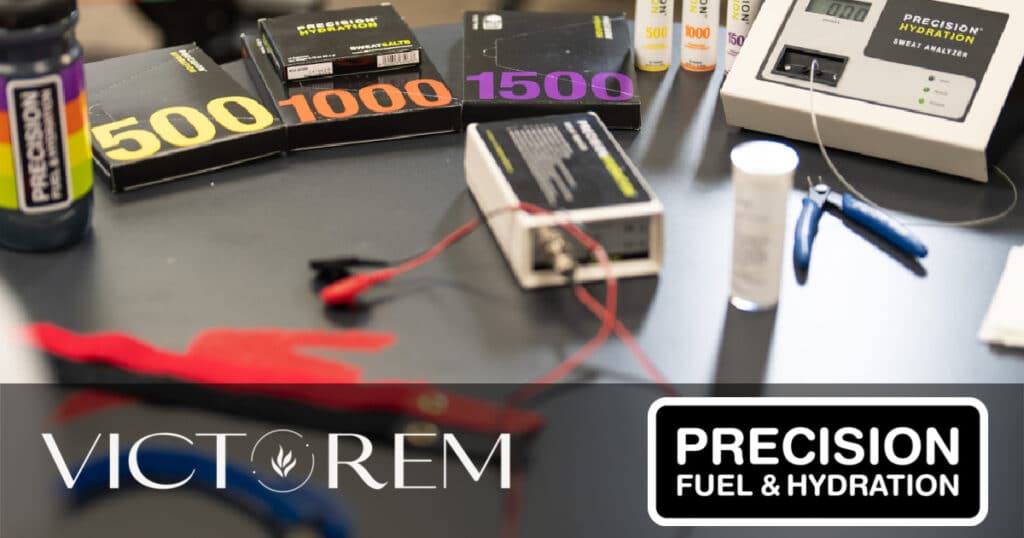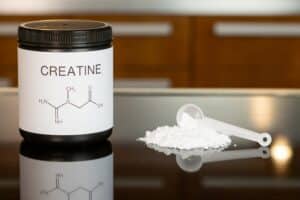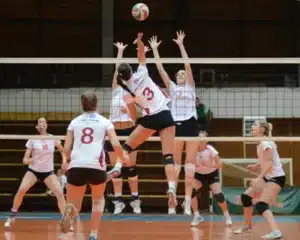Do you struggle with hydration during your exercise?
Are you wondering if there is a sweat test for athletes to improve your heat tolerance and exercise performance level…especially as the temperatures (and humidity) begin to climb as summer approaches?
Hi! As a sports dietitian and endurance athlete living in the {HOT and humid} state of Texas, I am here to help guide you through the process of dialing in your hydration plan to support and improve your exercise performance and recovery.
We will cover a lot of distance in this blog discussing:
- The difference between sweat volume and sweat sodium
- What is sweat sodium testing?
- Why sweat sodium testing may improve your performance
- How to recognize signs of a salty sweater
- Additional considerations before testing
- Signs & symptoms of dehydration
- How to determine fluid replacement
Let’s start with one idea that athletes often have some confusion about: sweat volume versus sweat sodium.
Sweat volume versus sweat sodium
For optimal advantage, a comprehensive sweat test for athletes should include both sweat volume and sweat sodium. But first, let’s clarify the difference between the two.
Sweat volume testing (often referred to as a ‘sweat test’) measures the amount of fluid you lose per hour during a given exercise.
This number is called your sweat rate.
A sports dietitian will use this data in units of liters per hour (L/hr) but can easily translate this into ounces per hour (oz/hr) for you.
Quick conversion → liters per hour ÷ 33.8 = ounces per hour
Sweat sodium testing measures the amount of sodium you lose per liter of sweat.
This number is your sweat sodium concentration.
PRO TIP: It is good practice to test your sweat volume under different climate conditions and different sports if you participate in multiple sports (e.g. a triathlon).
Testing under different climate conditions helps you better understand your individual response to different temperatures and environments. You will probably sweat more in 95 degree heat and high humidity than 40 degrees and low humidity, right?
Also, from a practical standpoint, it is best to test in the sport you plan to compete in. With the same mindset, it would not make sense for a football player who plays in the Texas heat (wearing pads!) to do an indoor sweat test in gym clothes.
This is some pretty fancy information, but you are probably wondering…what is sweat sodium testing?!
What is sweat sodium testing?
There are three commonly recognized methods of sweat sodium testing:
- Whole Body Washdown (WBW)
- Patch testing
- Non-exercise testing

The WBW method is considered the ‘gold standard’…but requires you to wash your body with deionized water and exercise in an enclosed plastic environment. (1) For obvious reasons, this method is not very practical and not used outside the research environment.
Sweat patch testing is worn during exercise and has been validated under specific testing conditions. The practicality of testing conditions under normal training environments may lead to invalid results (such as physical contact with the patch or clothing interference).
Non-exercise sweat sodium testing using Precision Hydration’s technology is a quick, simple, noninvasive test taken at rest in 3 easy steps.
Step 1: Sweat is induced on your forearm using electrode stimulation (this step takes 5 minutes).
Step 2: The electrodes are removed and a sweat collector is attached to your forearm (this step takes 5 to 20 minutes).
Step 3: Collected sweat is fed through a sweat analyzer. Your sweat sodium concentration is displayed as mmol/L, and your sports dietitian will provide you with your sweat sodium concentration as milligrams per liter (mg/L) of sweat.
This method is referred to as localized sweat stimulation via pilocarpine iontophoresis and may result in higher sodium concentrations (1)*. However, this method offers many benefits and results are best interpreted by a sports dietitian or other trained professional.
A non-exercise sweat sodium test offers many benefits for the athlete:
- Testing at rest reduces the risk of testing error
- Less time
- Immediate, accurate* results
- Can be performed almost anywhere
- Easily implemented into a usable training plan
- One-time test (it does not change significantly over time and does not need to be repeated)
- {Bonus} You get to keep your clothes on!
The process of sweat sodium testing is not scary or dangerous, but if the thought of attaching electrodes to your body makes you feel uneasy check out this quick video about what to expect at your sweat test.
It is important to note that there are limitations to all current sweat sodium testing methods. Talk to your sports dietitian to determine which method is the most practical testing option for you.
Sweat volume and sweat sodium concentration are both important, but let’s discuss why it is important to know your sweat sodium concentration.
Why is sweat sodium concentration important for hydration?
Sweat is primarily made up of water (this is where sweat volume comes in handy!), but it also contains electrolytes essential for the body and performance.
Electrolyte balance helps maintain blood volume. This is important for athletes because without enough blood volume, your muscles get tired more quickly. Enough blood volume allows you to exercise at a higher intensity for a longer duration of time. (3)
The primary electrolyte that you lose in sweat is sodium. Chloride is a close second. (4) Sodium, chloride, and potassium work together to help regulate and maintain fluid balance (a fancy way of saying that you have enough fluid in your body to meet your needs and to keep your electrolyte concentration where it should be). Other electrolytes lost in smaller amounts include magnesium and calcium.

The average athlete loses 1 to 3 liters of sweat per hour, but sweat sodium concentration can range from as little as 200 mg up to as high as 2,000 mg of sodium per liter.
Personally, I am a ‘very salty sweater’ losing over 1,500 mg per liter of sweat. As an endurance athlete with very salty sweat {living in Texas}, my performance has been positively affected from knowing this information.
To put this in perspective, let’s look at some numbers and how this might impact your losses over a 3-hour bout of exercise.
If you are a heavy sweater losing 2 L/hr with a concentration of 1,500 mg/L – you lose 6 liters of fluid and ~9,000 mg sodium in 3 hours.
Your strategy to maintain blood volume at that amount of fluid and sodium loss is very different from losing 1 L/hr (or even less for some athletes!) with a sweat sodium concentration of ~300 mg/L. In this case, you only lose 3 liters of fluid and 900 mg of sodium in 3 hours.
Knowing your body’s usual sweat and salt losses during exercise empowers you to better take care of your body’s needs and can boost your performance.

Maintaining blood volume during exercise is essential to provide blood flow to working muscles.
Replenishing blood volume after exercise is essential for faster recovery. Optimal blood flow to muscles helps to remove normal toxins released during intense activity and reduce muscle fatigue.
Sweat sodium testing is not required to know if you are a salty sweater. In fact, you may already know or suspect that you are a salty sweater just by noticing a few signs and symptoms.
So, how do you know if you are a salty sweater?
Signs of a Salty Sweater
- White residue on your skin or clothing
- Sweat stings your eyes or burns if it runs into cuts or grazes on the skin
- Sweat tastes salty
- Headaches during exercise or chronic
- Cramping during exercise or at other times
- Feeling faint or suffering head rushes when standing up too quickly after exercise
- Craving salty foods during and/or after exercise
Just because you may have some of these signs does not mean you must test sweat sodium concentration. However, if you are an athlete who does have signs of a salty sweater AND you want to optimize your performance or edge, there are some additional signals that you should test your sweat sodium concentration.
Athletes who may benefit from sweat testing
- Exercise in the heat or humidity for over 1 hour
- Heavy sweater
- Endurance athlete
- 2+ training sessions per day
- History of heat stroke or heat intolerance
- Altitude training
- Masters athlete
All athletes can benefit from sweat volume testing, but sweat sodium testing may not be as necessary or practical for some athletes unless you are experiencing significant heat intolerance and dehydration problems.
Download Our Free Personalized Hydration Plan!
Knowing how to optimize your hydration based on your personal sweat and sodium rates may provide a significant competitive advantage for you…especially if you live where it is hot and humid. This is one of many reasons that working with a sports dietitian can really make an impact on your performance this season.
This list is not an exhaustive list, but a practical application of testing may be relative if you play:
- Baseball
- Basketball
- Cricket
- Endurance (marathon, ultra, triathlon)
- Football
- Golf
- Lacrosse
- Motocross
- Soccer
- Masters athletes
- More!
As the saying goes, “we don’t know what we don’t know” and ‘normal’ becomes relative to your personal experience. If you have always exercised dehydrated, how do you know if you are dehydrated?
Signs & Symptoms of Dehydration
Do you know the signs of dehydration? There are many…it isn’t just feeling thirsty.
PRO TIP: Thirst may be a late sign of dehydration. (5) (6)
- Headaches, dizziness, or light-headedness
- Muscle cramping
- Thirst or dry mouth
- Muscle fatigue
- Deep or rapid breathing
- Low blood pressure and/or weak pulse
- Temperature drop (especially the extremities)
- Dry eyes
- Confusion or disorientation
In practical terms, the easiest way to observe hydration status is by checking your urine (pee!) color. I know that this might feel a little weird, but the color provides you with helpful info every time you go to the bathroom. Aim for light lemonade-colored urine. Apple juice-colored urine means that you’re dehydrated – drink up!
Note: It is possible to drink too much; clear urine may indicate that you are not absorbing all of the fluids you are consuming, and it is never recommended to drink so much that you gain weight during exercise.

Weight loss during exercise is another method of monitoring how well you are hydrated. The general rule is to aim for less than 2% body weight loss during exercise.
This method is most accurate if you weigh without clothes immediately before and after exercise. (1) It is the best method to use when running a sweat test, but it is not always a practical solution for other exercise situations. (I don’t know about you, but the last time I stripped down at the starting line to get a before-exercise weight was probably in college! Just kidding.)
If you experience signs of a salty sweater, fit the criteria for additional considerations, and suffer signs & symptoms of dehydration, I strongly recommend consulting with a sports dietitian to perform a sweat volume and sweat sodium test.
Knowing your sweat volume and sweat sodium needs while monitoring your urine color as an indication of hydration status are great tools, but replacing fluid loss is not always as straight forward. In fact, as long as you arrive well hydrated, the more sweat you lose, the less fluid you will replace. What?!?
Do you have to replace all fluid and sodium loss?
Your fluid and electrolyte replacement needs are likely different from those of your teammates or training buddies. It is important to keep a tailored mindset rather than ‘whatever works for them will work for me’.
Trying to mimic your teammates may backfire and may result in under or over-hydrating, GI distress, or suboptimal performance.
Replacing 100% of your fluid and electrolyte loss is not always necessary or practical, but you can train your gut to tolerate more fluid if you haven’t been drinking enough. (7) Consult with a sports dietitian to help you create a personalized hydration and fueling plan.
Wondering why you would replace less fluid the more you sweat?! While some of us are naturally heavy sweaters, you may be a heavy sweater simply because you are exercising at a very high intensity. Fluid replacement at higher intensities is difficult from a practical standpoint and there is only so much fluid your stomach can tolerate without negative side effects.
At higher volume and higher intensity, aim to arrive hydrated and replace as much fluid as practically possible.
Refer to the chart below as a starting point for suggested fluid replacement per hour assuming you begin exercise well-hydrated.
| Sweat Rate | | Aim for: |
| < 1.0 L/hr | low | ~10-16 oz/hr |
| 1 – 1.5 L/hr | normal to moderate | ~24 oz/hr |
| > 1.5 – 2.5 L/hr | high | up to ~34 oz/hr |
| > 2.5 L/hr | very high | |
Adjust your individual plan based on: (8) (9)
- hydration status before exercise
- body weight and size
- fitness level
- environment
- intensity of exercise
- age
- menstrual phase (women)
Dialing it all in
Hydration plans should be fluid (pun intended!) and are not one-size-fits-all. Whatever plan you follow, trial it during smaller training sessions before a competition, make relevant notes on each session, and adjust your sodium and fluid intake based on your experience.
Sweat volume and sweat sodium concentration data provide a lot of insight into your own physiological response to different exercises and environmental conditions, but you always have to call the game and think on your feet (are you loving my analogies today?!?).
Regardless of the circumstances out of your control (weather, fluid availability, etc.), always aim to begin exercise well-hydrated. (9)
Schedule a consultation with a sports dietitian to discuss your hydration needs for training, competition, and sport.
Download Our Free Personalized Hydration Plan!
Bring this presentation and testing to your group, team, or club! We can discuss hydration in more detail including fluid loading and how to choose a specific hydration product for YOU.








